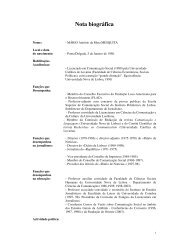A decade later - Fundação Luso-Americana
A decade later - Fundação Luso-Americana
A decade later - Fundação Luso-Americana
You also want an ePaper? Increase the reach of your titles
YUMPU automatically turns print PDFs into web optimized ePapers that Google loves.
as in the past, female criminality is much<br />
lower than delinquency among males.<br />
While 58 women out of 100 thousand are<br />
doing time, the figure for men is 896 out<br />
of 100 thousand. Therefore, fewer prisons<br />
are built to house females, and there is<br />
much less likelihood that an inmate will be<br />
incarcerated close to home.<br />
New York was the first state to open a<br />
prison nursery for the inmates’ children in<br />
1902. It would take nearly a century for the<br />
other states to follow suit. Repeating New<br />
York’s former groundbreaking initiative –<br />
but in 1994 – Nebraska opened its first<br />
prison nursery. Since the late 90s, an additional<br />
seven child-care facilities have opened<br />
throughout America’s correctional system.<br />
The Tires correctional establishment for<br />
women in Portugal, inaugurated in 1953,<br />
has always allowed children on the premises.<br />
However, though the country has<br />
considerable experience with children<br />
being raised inside the penitentiary, no<br />
studies have been done to assess the effectiveness<br />
of the measure.<br />
The National Women’s Law Center in<br />
Washington DC notes that between 1980<br />
and 1993 women made up the fastest<br />
growing prison population with a 313%,<br />
growth rate as opposed to the 182%<br />
growth rate for men during the same<br />
period. If we go as far back as the 70s,<br />
we see that the growth rate for female<br />
inmates has ballooned 800 percent.<br />
Besides all the other social constraints<br />
linked to motherhood behind bars, the<br />
American inmates must grapple with another<br />
issue that has been widely overlooked<br />
by the US correctional system which is predominantly<br />
male-directed – distance. Sandra<br />
Enos cites research from 1993 stating that<br />
“more than half the women in prison have<br />
never been visited by their children while<br />
incarcerated.” The distance between their<br />
homes and where they are detained weighs<br />
heavily in the visitation issue: “over 60 percent<br />
of female inmates are over 150 kilometers<br />
away from their families.”<br />
Augustine is another among the countless<br />
women who have forfeited their lives to the<br />
justice system. With a tight black braid<br />
wound as a hairband across her head and a<br />
smoldering look of anger from having spent<br />
the lion’s share of her life in and out of<br />
prison, the 54-year-old is in jail because of<br />
“an accident with drugs.” Her checkered<br />
past includes a 12-year-old son who has<br />
been in and out of foster care since he was<br />
18 months old – all because of cocaine.<br />
They deal to feed their own habits, to<br />
support their families, or cater to their<br />
partner’s addiction. Drug dealing is the<br />
socieTy<br />
“more than half the inmates have never been visited by their children,”<br />
sandra enos states in her study.<br />
common thread that runs through these<br />
women’s lives both in Portugal and in the<br />
United States – in one of the poorest countries<br />
of the European Union and one of<br />
the richest nations in the world.<br />
Augustine is getting out again in four<br />
months. Waiting for her on the outside are<br />
five children and twelve grandchildren. One<br />
of the girls already has a rap sheet; one of<br />
the boys received two death sentences.<br />
After so many years of cumulative prison<br />
time, she knows her script and has her lines<br />
down pat: “I raised my kids the best I<br />
could. If they do what they do, that’s their<br />
responsibility. I only ask the Lord to forgive<br />
me while I try to move forward. But I’ve<br />
been in and out of jail since I was a kid.”<br />
Her narrative is so stark that it reminds<br />
me of one of the ironies that goes along<br />
with this type of life: the more brutal the<br />
memories, the more urgent it is to summarize<br />
them. Most of the women sitting<br />
around me in this room in a Rhode Island<br />
prison portray their pasts as Augustine<br />
does – spewing out their life stories with<br />
such jarring harshness that it seems they<br />
want to stun the listener and divest him<br />
of the urge to judge.<br />
When they open the huge front gate for<br />
me to leave I almost run into a large, smiling<br />
black woman. She reminds me of Adilia,<br />
the Portuguese inmate I spoke to when she<br />
went into labor in the Tires women’s facility<br />
before I left for the States. I can see her<br />
panting with pain in an unbreathably hot<br />
cell. That’s when I decided to learn more<br />
about giving birth in prison.<br />
In Rhode Island the women get their handcuffs<br />
taken off during labor, but are chained<br />
to the bed by the ankle as soon as the baby<br />
is born. That’s the way it’s done in this<br />
prison. In other states, female convicts still<br />
have to give birth with their handcuffs on.<br />
It was as late as 2008 when the Federal<br />
Bureau of Prisons ruled that the shackles<br />
could be removed during labor in state<br />
prisons. According to the National Women’s<br />
Law Center, there is now a more widespread<br />
consensus on the issue, since shackling<br />
made it harder for the obstetrician to<br />
get to the mother and the newborn. But<br />
there is still no national legislation on the<br />
issue, which means that each district can<br />
basically make up its own rules.<br />
The United States and Russia are the counties<br />
with the world’s largest female prisons.<br />
In this Rhode Island correctional facility<br />
there are 6 to 8 women per cell. They are<br />
cramped together in the same space 17<br />
hours a day. Each minute is monitored by<br />
the authorities. They cannot touch each<br />
other or have a cigarette or put on a speck<br />
of make-up. The heat is suffocating. It’s easy<br />
to go crazy in a place like this.<br />
1. To safeguard their privacy, the names of the inmates and<br />
prison guards have been changed.<br />
2. This article has been excerpted from a book on mothers<br />
in the prison system, to be published by Livros de Seda,<br />
Plátano Editora publishers, and a feature article to be published<br />
in the weekly magazine Visão.<br />
Parallel no. 6 | FALL | WINTER 2011 63<br />
DR
















